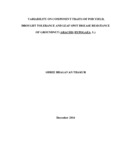Please use this identifier to cite or link to this item:
http://archive.nnl.gov.np:8080/handle/123456789/390| Title: | Variability on component traits of pod yield, drought tolerance and leaf spot disease resistance of groundnut (arachis hypogaea. L.) |
| Authors: | Thakur, Shree Bhagavan |
| Keywords: | Groundnut -- Nepal |
| Issue Date: | 13-Dec-2017 |
| Abstract: | The experiment was conducted in a Randomized Complete Block Design (RCBD) with 3 replications at National Oilseed Research Program (NORP), Nawalpur, Sarlahi "Genetic variability on component traits of pod yield, drought tolerance and leaf spot disease resistance of groundnut (Arachis hypogaea. L.)" during rainy season 2010 and 2011. Twenty five groundnut genotypes were collected from National Oilseed Research Program (NORP), Nawalpur, Sarlahi Nepal including local checks (B -4, Jayanti and Baidehi) and used for the study. Observations were collected from randomly selected five plants from each plot and averaged. Data were computed and analyzed using SPSS software. Highly significant variations were observed for all the characters in all the genotypes. Higher phenotypic coefficients of variations were observed for days to 75% flowering, days to maturity, plant height, pods plant-1, seed pod -1, 100 kernel weight, pod length, pod width, seed length, seed width, selling % and sound matured kernel %. Slightly higher Phenotypic co-efficient of variation was observed for all the traits compare to genotypic co-efficient of variation indicating lesser effect of environment on the traits. The character 100 kernel weight showed high heritability with high genetic advance and high genetic advance in percentage of mean. Considerable high heritability, low genetic advance and genetic advances in percentage of mean were found for days to maturity. The genotype ICGV-99171, ICGV-98089, ICGV-97100, Baidehi, ICGV-00440, and B-4 performed better under drought condition with high pod yield. Hence, it is suggested that these genotypes could be grown under regions of limited rainfall. These lines may be used as parents in breeding program for developing drought tolerant groundnut cultivars. The results indicated that genotype ICGV-91074, ICGV-88473, ICGV-92173, B- 4, Rajashri, ICGV-91104 and ICGV-98089 had lower level of Cercospora leaf spot disease incidence. Genotypes ICGV-91074, ICGV-98089, ICGV-92173 and ICGV- 88473 produced higher pod yield and also had lower Cercospora leaf spot incidence. Genotypes ICGV-91104, ICGV-92173, B-4 and ICGV-91074 produced higher haulm yield and had the lower Cercospora leaf spot incidence. This study indicated that development or selection of tolerant/ resistant genotypes against leaf spot disease should be based on their level of disease incidence. Therefore, potential source of genetic resistance to this disease exist for selection among genotypes used in this study. Pod yield showed highly significant positive association with days to maturity, haulm yield and pod length. Significant positive correlation with oil percent was observed with SLA and SMK percent. Therefore, pod length and haulm yield are important traits for pod yield and SLA and SMK percent are important for oil percent. These traits should be considered while selecting for yield and oil content. ICGV-98089, ICGV-92173, ICGV-88473, ICGV-91074, ICGV-00350, ICGV- 97100 and ICGV-99171 were found higher pod yield, oil % and protein % compared to traditional genotype B-4 and Jayanti. Days to maturity, root length, pod length and pod width showed direct and positive contribution to pod yield. The correlation co-efficient of the pod yield ha-1 with days to maturity, SMK%, pod length, pod width and kernel length was highly significant and positive. The highly significant and negative association of the pod yield ha-1 with days to flowering, pod plant-1, shoots length, shelling percent and specific leaf area showed. Days to maturity, root length, pod width, pod length and kernel length made the individual high positive direct contribution to pod yield ha-1 while partitioning component of the total yield. Days to flowering, shoot length, shelling percent, SMK percent and100 kernel weights showed direct negative contribution with pod yield ha-1. Therefore, days to maturity, root length, pod width, pod length and kernel length were identified to be the important traits which could be used in selection for yield. |
| Description: | Dissertation Ssubmitted to the Tribhuvan University Institute of Agriculture and Animal Sciences, Rampur, Chitwan, Nepal in the fulfillment of the requirements for the Award of the Degree of Doctor of Philosophy (ph.d.) in Agriculture (Plant breeding), 2014. |
| URI: | http://103.69.125.248:8080/xmlui/handle/123456789/390 |
| Appears in Collections: | 600 Technology (Applied sciences) |
Files in This Item:
| File | Description | Size | Format | |
|---|---|---|---|---|
| GROUNDNUT THESIS FINAL 14 NOV 014_PDF.pdf | 1.52 MB | Adobe PDF |  View/Open |
Items in DSpace are protected by copyright, with all rights reserved, unless otherwise indicated.